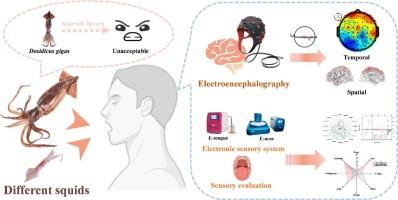Effects of different sour off-flavor in jumbo squid (Dosidicus gigas) on brain perceptions via scalp electroencephalogram and the underlying mechanisms
IF 8
1区 农林科学
Q1 FOOD SCIENCE & TECHNOLOGY
引用次数: 0
Abstract
The commercial utilization of jumbo squid (Dosidicus gigas) faces significant constraints due to its pronounced sour off-flavor. This investigation employed a multimodal approach combining electroencephalography (EEG), electronic sensing technology, and conventional sensory evaluation to characterize the perceptual attributes and neural correlates of varying off-flavor intensities, aiming to explore the underlying mechanisms. Sensory profiling indicated that sour off-flavor of jumbo squid was mainly attributed to the combined effects of sourness, bitterness, and persistent aftertaste. Further analysis using the electronic tongue and electronic nose clarified the distinct characteristics of the squid sour off-flavor at varying intensities. The spectrum analysis of averaged EEG signals revealed robust neural activation patterns, with particularly prominent responses in the δ and α frequency bands. Distinct levels of sour off-flavor elicited clearly different temporal dynamics, with perceptual distinctions emerging within the 0–200 and 950–1500 ms following stimulus onset. Notably, the topographical distribution and source localization results suggested that increasing off-flavor intensity elicited progressively stronger neural activation, with the prefrontal cortex and right temporal lobe showing the most pronounced responses. By employing EEG for comparative analysis of sour off-flavor intensities in jumbo squid, this study provides novel insights into the neurophysiological mechanisms underlying off-flavor perception. Therefore, EEG is proved as a promising objective assessment tool for quantifying subtle flavor variations often missed by conventional sensory panels in seafood quality evaluation.

不同酸味对巨型鱿鱼脑电感知的影响及其机制
巨型鱿鱼由于其明显的酸味,其商业利用面临着很大的限制。本研究采用脑电图(EEG)、电子传感技术和常规感官评价相结合的多模态方法来表征不同异味强度的感知属性和神经相关性,旨在探讨其潜在机制。感官分析表明,大鱿鱼的酸味主要是由酸味、苦味和持久余味的综合作用所致。利用电子舌和电子鼻进一步分析,明确了鱿鱼酸味在不同强度下的独特特征。平均脑电图信号的频谱分析显示了强大的神经激活模式,其中δ和α频段的响应尤为突出。不同程度的酸味引发了明显不同的时间动态,在刺激开始后的0-200和950-1500 ms内出现了感知差异。值得注意的是,地形分布和来源定位结果表明,增加的异味强度引发了逐渐增强的神经激活,其中前额叶皮层和右颞叶表现出最明显的反应。通过脑电图对巨型鱿鱼酸味强度的对比分析,本研究为研究鱿鱼酸味感知的神经生理机制提供了新的见解。因此,EEG被证明是一种很有前景的客观评估工具,可以量化传统感官面板在海鲜质量评估中经常遗漏的细微风味变化。
本文章由计算机程序翻译,如有差异,请以英文原文为准。
求助全文
约1分钟内获得全文
求助全文
来源期刊

Food Research International
工程技术-食品科技
CiteScore
12.50
自引率
7.40%
发文量
1183
审稿时长
79 days
期刊介绍:
Food Research International serves as a rapid dissemination platform for significant and impactful research in food science, technology, engineering, and nutrition. The journal focuses on publishing novel, high-quality, and high-impact review papers, original research papers, and letters to the editors across various disciplines in the science and technology of food. Additionally, it follows a policy of publishing special issues on topical and emergent subjects in food research or related areas. Selected, peer-reviewed papers from scientific meetings, workshops, and conferences on the science, technology, and engineering of foods are also featured in special issues.
 求助内容:
求助内容: 应助结果提醒方式:
应助结果提醒方式:


